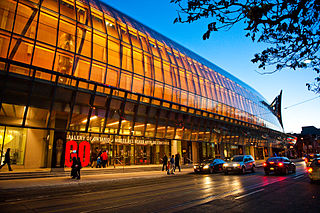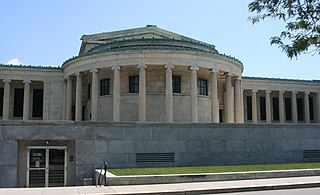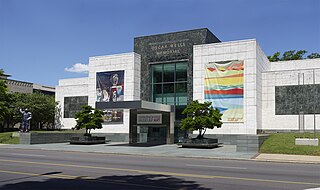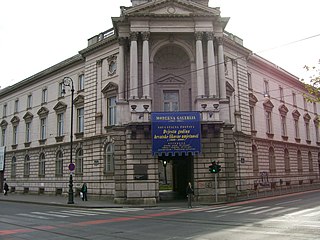
The Metropolitan Museum of Art of New York City, colloquially "the Met", is the largest art museum in the United States. With 6,479,548 visitors to its three locations in 2019, it was the fourth most visited art museum in the world. Its permanent collection contains over two million works, divided among 17 curatorial departments. The main building at 1000 Fifth Avenue, along the Museum Mile on the eastern edge of Central Park in Manhattan's Upper East Side, is by area one of the world's largest art galleries. A much smaller second location, The Cloisters at Fort Tryon Park in Upper Manhattan, contains an extensive collection of art, architecture, and artifacts from medieval Europe. On March 18, 2016, the museum opened the Met Breuer museum along Madison Avenue on the Upper East Side; it extends the museum's modern and contemporary art program.

Osijek is the fourth largest city in Croatia with a population of 108,048 in 2011. It is the largest city and the economic and cultural centre of the eastern Croatian region of Slavonia, as well as the administrative centre of Osijek-Baranja County. Osijek is located on the right bank of the river Drava, 25 kilometres (16 mi) upstream of its confluence with the Danube, at an elevation of 94 metres (308 ft).

Vukovar is a city in eastern Croatia. It contains Croatia's largest river port, located at the confluence of the Vuka and the Danube. Vukovar is the seat of Vukovar-Syrmia County. The city's registered population was 26,468 in the 2011 census, with a total of 27,683 in the municipality.

The National Gallery of Canada, located in the capital city of Ottawa, Ontario, is Canada's national art museum. The museum's building takes up 46,621 square metres (501,820 sq ft), with 12,400 square metres (133,000 sq ft) of space used for exhibiting art; making the museum one of the largest art museums in North America by exhibition space.

The Art Gallery of Ontario is an art museum in Toronto, Ontario, Canada. The museum is located in the Grange Park neighbourhood of downtown Toronto, on Dundas Street West between McCaul and Beverley streets. The museum's building complex takes up 45,000 square metres (480,000 sq ft) of physical space, making it one of the largest art museums in North America. In addition to exhibition spaces, the museum also houses an artist-in-residence office and studio, dining facilities, event spaces, gift shop, library and archives, theatre and lecture hall, research centre, and a workshop.

The Albright–Knox Art Gallery is an art museum located at 1285 Elmwood Avenue, Buffalo, New York, in Delaware Park. The Albright-Knox's Elmwood Avenue campus is temporarily closed for construction. It is currently hosting exhibitions and events at Albright-Knox Northland, a project space located at 612 Northland Avenue in Buffalo’s Northland Corridor. The new Buffalo Albright Knox Gundlach Art Museum (AKG) is expected to open in 2022.

The Frans Hals Museum is a museum located in Haarlem, the Netherlands.
Oton Gliha was a Croatian artist, born in Slovenia. A graduate of the Academy of fine Arts in Zagreb, Gliha continued his studies in Paris, Vienna and Munich. He is best known for his series of abstract paintings based on the patterns of the drystone walls of coastal Croatia. The first in the series appeared in 1954, and it was a theme he developed for the rest of his life.

The Honolulu Museum of Art is an art museum in Honolulu, Hawaiʻi. The museum is the largest of its kind in the state, and was founded in 1922 by Anna Rice Cooke. The museum has one of the largest single collections of Asian and Pan-Pacific art in the United States, and since its official opening on April 8, 1927, its collections have grown to more than 50,000 works of art.

The Cincinnati Art Museum is an art museum in the Eden Park neighborhood of Cincinnati, Ohio. Founded in 1881, it was the first purpose-built art museum west of the Alleghenies, and is one of the oldest in the United States. Its collection of over 100,000 works spanning 6,000 years of human history make it one of the most comprehensive collections in the Midwest.

Founded in 1951, the Birmingham Museum of Art in Birmingham, Alabama, today has one of the finest collections in the Southeastern United States, with more than 24,000 paintings, sculptures, prints, drawings, and decorative arts representing a numerous diverse cultures, including Asian, European, American, African, Pre-Columbian, and Native American. Among other highlights, the Museum’s collection of Asian art is considered the finest and most comprehensive in the Southeast, and its Vietnamese ceramics one of the finest in the U.S. The Museum also is home to a remarkable Kress Collection of Renaissance and Baroque paintings, sculpture, and decorative arts from the late 13th century to c.1750, and the 18th-century European decorative arts include superior examples of English ceramics and French furniture.

The Zachęta National Gallery of Art is a contemporary-art museum in the center of Warsaw, Poland. The Gallery's chief purpose is to present and support Polish contemporary art and artists. With numerous temporary exhibitions of well-known foreign artists, the gallery has also established itself internationally.

The MIT Museum, founded in 1971, is located at the Massachusetts Institute of Technology in Cambridge, Massachusetts. It hosts collections of holography, technology-related artworks, artificial intelligence, robotics, maritime history, and the history of MIT. Its holography collection of 1800 pieces is the largest in the world, though not all of it is exhibited. As of 2019, holographic art, and works by the kinetic artist Arthur Ganson are the two largest long-running displays. There is a regular program of temporary special exhibitions, often on the intersections of art and technology.
The Marinko Sudac Collection, based in Zagreb, Croatia, has been created with a clear collecting strategy based on the region of Central and Eastern Europe, additionally spanning from the Baltic area to the Black Sea. The guiding principle of the Collection is systematic exploration, researching, and promotion of the avant-garde practices which have been marginalized, forbidden, and at times completely negated due to the historical, social and political circumstances. In this context, the Marinko Sudac Collection gives the most complete and comprehensive overview on the art of this region. The Collection starts at 1909, and it show the continuity from the first Avant-Gardes, through neo-avant-garde and New Artistic Practices, ending with the fall of the Berlin Wall. The global uniqueness of the Marinko Sudac Collection is also seen in the kind of media it contains. It contains not only traditional artworks, such as paintings, sculptures, and photographs, but it gives equal importance to documentary and archival material. Great importance is put on these almost forgotten media, which enable research of specific phenomena, artists and the socio-political situation which affected this type of art. The Collection contains a great number of museological units, and it treats the documentary and archival material on the same level as traditional artworks. By examining the units contained in the Marinko Sudac Collection, one can read not only the art scene or the art production of a certain artist, but the full status of the society, the socio-political atmosphere of the region in which this art was created in.

Modern Gallery is a museum in Zagreb, Croatia that holds the most important and comprehensive collection of paintings, sculptures and drawings by 19th and 20th century Croatian artists. The collection numbers around 10,000 works of art, housed since 1934 in the historic Vranyczany Palace in the centre of Zagreb, overlooking the Zrinjevac Park. A secondary gallery is the Josip Račić Studio at Margaretska 3.

Ivan Meštrović Gallery, is an art museum in Split, Croatia dedicated to the work of the 20th-century sculptor, Ivan Meštrović. The gallery preserves and presents to the public the most significant works of Meštrović, and is in itself an art monument. The permanent collection includes works of sculpture, drawings, design, furniture and architecture. Holdings include original plaster models by the artist, as well as finished works in bronze, marble and wood. The gallery building and grounds were based on original plans by Meštrović himself, and included living and working areas, as well as exhibition spaces.

The Museum of Fine Arts, is an art museum in Split, Croatia containing works from the 14th century up to the present day providing an overview of the artistic developments in the local art scene. The museum was founded in 1931, and has a permanent exhibition of paintings and sculptures that includes works by major Croatian artists such as Vlaho Bukovac, Mato Celestin Medović, Branislav Dešković, Ivan Meštrović, Emanuel Vidović and Ignjat Job. The museum also has an extensive collection of icons, and holds special exhibits of works by contemporary artists.
Lauba is a private-owned contemporary art gallery in the Črnomerec district of Zagreb, Croatia. It houses exhibits from the Lauba collection, a large private collection of works by modern and postmodern Croatian artists. The venue is also used for exhibitions of foreign contemporary artists and for hosting various arts-related events.
The City and University Library of Osijek is the city library of Osijek and the central library of the University of Osijek. It is the biggest library in Slavonia and one of the bigger ones in Croatia.

European Avenue is a street in Osijek, Croatia. It is the most representative and perhaps beautiful street in Osijek, with its string of secession buildings.

















